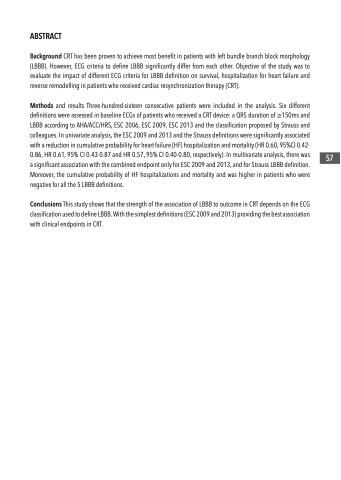Page 57 - Simplicity is Key in CRT
P. 57
ABSTRACT
Background CRT has been proven to achieve most benefit in patients with left bundle branch block morphology (LBBB). However, ECG criteria to define LBBB significantly differ from each other. Objective of the study was to evaluate the impact of different ECG criteria for LBBB definition on survival, hospitalization for heart failure and reverse remodelling in patients who received cardiac resynchronization therapy (CRT).
Methods and results Three-hundred-sixteen consecutive patients were included in the analysis. Six different definitions were assessed in baseline ECGs of patients who received a CRT device: a QRS duration of ≥150ms and LBBB according to AHA/ACC/HRS, ESC 2006, ESC 2009, ESC 2013 and the classification proposed by Strauss and colleagues. In univariate analysis, the ESC 2009 and 2013 and the Strauss definitions were significantly associated with a reduction in cumulative probability for heart failure (HF) hospitalization and mortality (HR 0.60, 95%CI 0.42- 0.86, HR 0.61, 95% CI 0.43-0.87 and HR 0.57, 95% CI 0.40-0.80, respectively). In multivariate analysis, there was a significant association with the combined endpoint only for ESC 2009 and 2013, and for Strauss LBBB definition. Moreover, the cumulative probability of HF hospitalizations and mortality and was higher in patients who were negative for all the 5 LBBB definitions.
Conclusions This study shows that the strength of the association of LBBB to outcome in CRT depends on the ECG classification used to define LBBB. With the simplest definitions (ESC 2009 and 2013) providing the best association with clinical endpoints in CRT.
57


